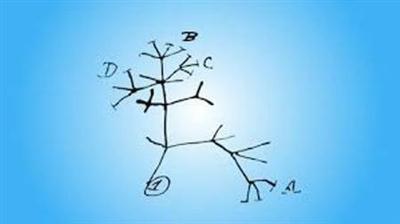Coursera - Computational Molecular Evolution
HDRips | MP4/AVC, ~155 kb/s | 960x540 | Duration: ~7 hours | English: AAC, 110 kb/s (2 ch) | Subtitles: English
Size: 682 MB | Genre: Biology
In this course you will learn about how and why DNA and protein sequences evolve. You will learn the theory behind methods for building and analyzing phylogenetic trees, and get hands-on experience with some widely used software packages.
This course is about molecular evolution - the evolution of DNA, RNA, and protein molecules. The focus is on computational methods for inferring phylogenetic trees from sequence data, and the course will give an introduction to the fundamental theory and algorithms, while also giving the student hands-on experience with some widely used software tools. Since evolutionary theory is the conceptual foundation of biology (in the words of Theodosius Dobzhansky: "Nothing in biology makes sense except in the light of evolution"), what you learn on this course will be relevant for any project you will ever do inside the life sciences. A phylogenetic tree will almost always help you think more clearly about your biological problem.
A special emphasis is put on methods that employ explicit models of the evolutionary process (maximum likelihood and Bayesian approaches), and we will explore the role of statistical modeling in molecular evolution, and in science more generally. A mathematical (statistical) model of a biological system can be considered to be a stringently phrased hypothesis about that system, and this way of thinking about models will often be helpful. In addition to model-based methods, you will also learn about other approaches, such as those based on parsimony and genetic distance (e.g., neighbor joining).
Often, the evolutionary tree is the result we are interested in - knowing how a set of sequences (or organisms) are related can provide us with important information about the biological problem we are investigating. For instance, knowing which organisms are most closely related to a newly identified, uncharacterized, pathogenic bacterium will allow you to infer many aspects of its lifestyle, thereby giving you important clues about how to fight it. In other cases, however, inferring the structure of the tree is not the goal: for instance, our main focus may instead be the detection of positions in a protein undergoing positive selection (indicating adaptation) or negative selection (indicating conserved functional importance). However, even in these cases, the underlying phylogenetic tree will be an important part of our hypothesis about (model of) how the proteins have been evolving, and will help in getting the correct answer.
Although the study of molecular evolution does require a certain level of mathematical understanding, this course has been designed to be accessible also for students with limited computational background (e.g., students of biology).
Buy Premium From My Links To Get Resumable Support,Max Speed & Support MeCode:Download ( NitroFlare ) http://nitroflare.com/view/0CF4BB898A7D59E/z4qxi.C.C.M.E.part1.rar http://nitroflare.com/view/7275625C4697480/z4qxi.C.C.M.E.part2.rar Download ( Uploaded ) http://uploaded.net/file/tcfibn51/z4qxi.C.C.M.E.part1.rar http://uploaded.net/file/zj6ptee5/z4qxi.C.C.M.E.part2.rar Download ( Rapidgator ) http://rapidgator.net/file/34f8302a2d107b2e0cd4aa1ffa7b3371/z4qxi.C.C.M.E.part1.rar.html http://rapidgator.net/file/6373f2147ab2c02ea9bfd6a046dae063/z4qxi.C.C.M.E.part2.rar.html Download (BigFile) https://www.bigfile.to/file/2kpRnfYvR7kG/z4qxi.C.C.M.E.part1.rar https://www.bigfile.to/file/dsGGEsHA6mMx/z4qxi.C.C.M.E.part2.rar Download (Turbobit) http://turbobit.net/g6nzd5b4h7xq/z4qxi.C.C.M.E.part1.rar.html http://turbobit.net/6fpdpuwlrrm8/z4qxi.C.C.M.E.part2.rar.html
Please visit our sponsors
Results 1 to 1 of 1
-
15-08-2016, 06:20 AM #1Banned

- Join Date
- Mar 2014
- Posts
- 25,742
- Feedback Score
- 0
- Thanks
- 0
- Thanked 0 Times in 0 Posts
 Coursera - Computational Molecular Evolution
Coursera - Computational Molecular Evolution
-
Sponsored Links
-
Sponsored Links
Thread Information
Users Browsing this Thread
There are currently 1 users browsing this thread. (0 members and 1 guests)
24 Hour Gold
Advertising
- Over 20.000 UNIQUE Daily!
- Get Maximum Exposure For Your Site!
- Get QUALITY Converting Traffic!
- Advertise Here Today!
Out Of Billions Of Website's Online.
Members Are Online From.
- Get Maximum Exposure For Your Site!
- Get QUALITY Converting Traffic!
- Advertise Here Today!
Out Of Billions Of Website's Online.
Members Are Online From.






 LinkBack URL
LinkBack URL About LinkBacks
About LinkBacks







